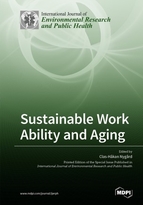Sustainable Work Ability and Aging
A special issue of International Journal of Environmental Research and Public Health (ISSN 1660-4601). This special issue belongs to the section "Occupational Safety and Health".
Deadline for manuscript submissions: closed (30 June 2019) | Viewed by 88296
Special Issue Editor
Interests: occupational health; aging and work; occupational gerontology; strain at work; work ability and promotion of health and work ability; ergonomics
Special Issues, Collections and Topics in MDPI journals
Special Issue Information
Dear Colleagues,
In many industrialized countries, there is a sharp increase of the aging population due to a decrease in fertility and an increase in life expectancy. Due to that, the age dependency ratio rises and may cause increased economic burden on the productive part of the population. One strategy to combat this is to prolong peoples working lives. A sufficient work ability is a requirement for a sustainable and prolonged employment. Work ability is primarily a question of balance between work and personal resources. Personal resources change with age, whereas work demands may not change parallel to that, or only change due to globalization or new technology. Work ability, on average, decreases with age, although several different work ability trajectories exist during the life course. Work-related factors, as well as general lifestyle, may explain the declines and improvements in work ability during aging. A sustainable work ability throughout the life course is a main incentive for a prolonged working live. Work ability and work-related factors, are therefore important occupational and public health issues when the age of a population increases.
This Special Issue, “Sustainable Work Ability and Aging”, offers an opportunity to publish high quality, multi-disciplinary work ability research. We are particularly interested in work ability research related to longitudinal studies, determinants, interventions, life course, older employees, prolonged work career, and any other interesting and important aspects of work ability.
Prof. Nygård Clas-Håkan
Guest Editor
Manuscript Submission Information
Manuscripts should be submitted online at www.mdpi.com by registering and logging in to this website. Once you are registered, click here to go to the submission form. Manuscripts can be submitted until the deadline. All submissions that pass pre-check are peer-reviewed. Accepted papers will be published continuously in the journal (as soon as accepted) and will be listed together on the special issue website. Research articles, review articles as well as short communications are invited. For planned papers, a title and short abstract (about 100 words) can be sent to the Editorial Office for announcement on this website.
Submitted manuscripts should not have been published previously, nor be under consideration for publication elsewhere (except conference proceedings papers). All manuscripts are thoroughly refereed through a single-blind peer-review process. A guide for authors and other relevant information for submission of manuscripts is available on the Instructions for Authors page. International Journal of Environmental Research and Public Health is an international peer-reviewed open access monthly journal published by MDPI.
Please visit the Instructions for Authors page before submitting a manuscript. The Article Processing Charge (APC) for publication in this open access journal is 2500 CHF (Swiss Francs). Submitted papers should be well formatted and use good English. Authors may use MDPI's English editing service prior to publication or during author revisions.
Keywords
- work ability
- interventions
- life course
- aging
- longitudinal studies
- prolonged work career
- elderly workers
- sustainability






